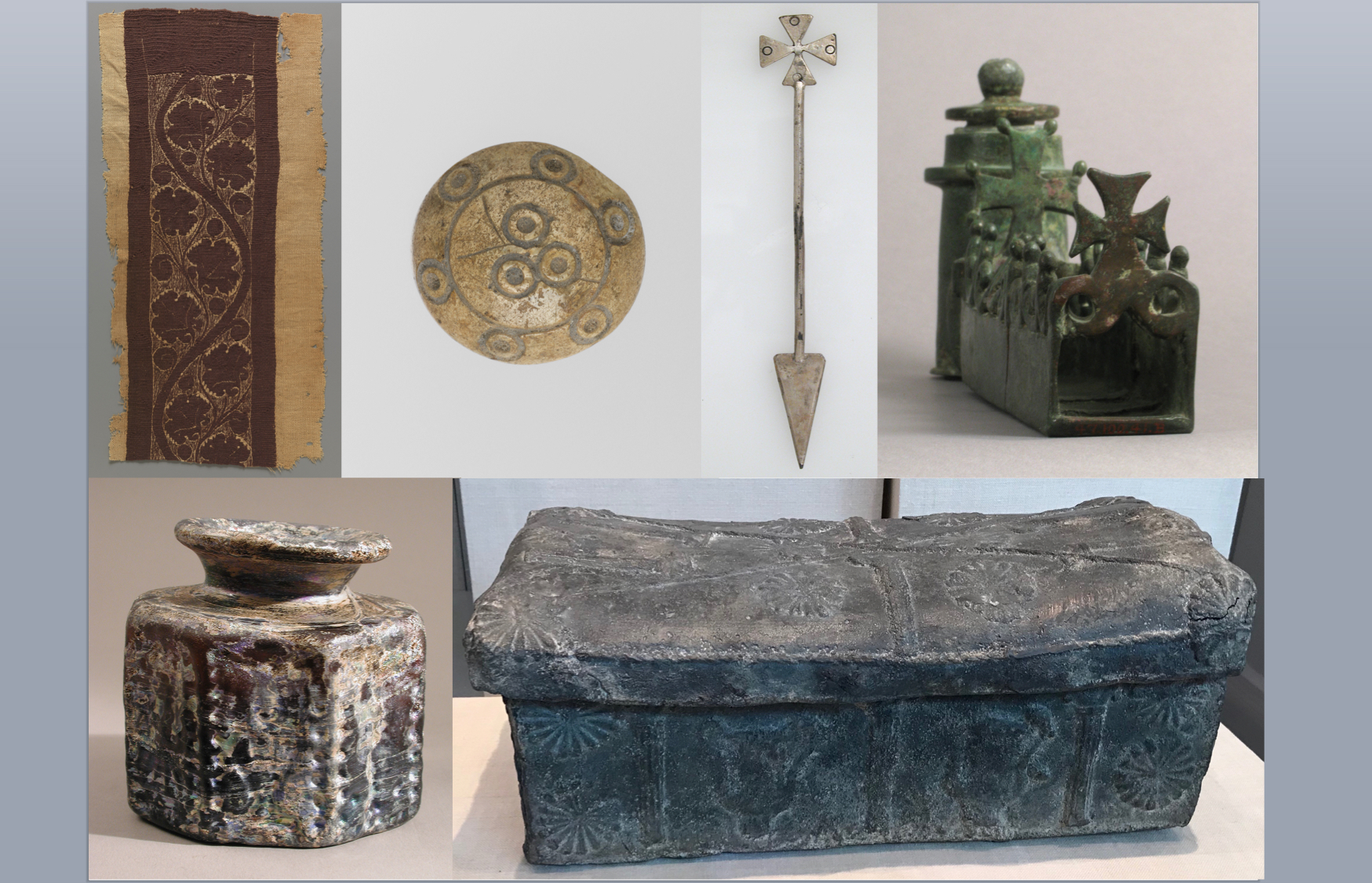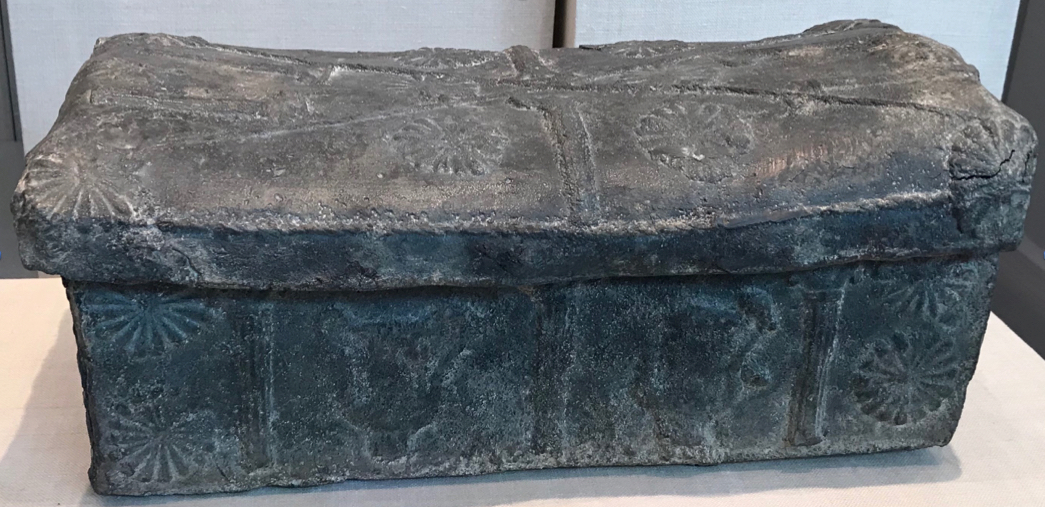A lead coffin (Met 61.206), at only 36cm long, would have held a newborn infant from Tyre, today in Lebanon. Now on display at the Metropolitan Museum of Art, a coffin of this size is rare and speaks to the modest wealth of the infant’s parents, to their desire to inter their child with proper ceremony. It bears witness to parental love and the hope for salvation, the skills of a local craftsman, and the chthonic qualities of lead, re-deposited in the earth thousands of miles from where it was extracted. The coffin’s decoration was formed by pressing designs into a mold of clay or sand into which the molten lead was poured. The designs betray their workshop, and each mold was unique. On the lid of the infant’s coffin are two knotted, braided ropes and on the sides, ends and lid are imprinted rosettes and columns, apotropaic symbols. The ropes figuratively bind the coffin and keep it closed, protecting the body from malign spirits. The coffin speaks to the fragility of human life in a society where life expectancy at birth was always below 30 years. Some were poisoned by lead, which the young absorb more readily than adults. Extant works of art in lead are rare, in part because lead is so easily recycled, and in part because it was not regarded as an appropriate medium for art. Lead was regarded as the antithesis of silver, a gleaming noble metal extracted from the same ore, lead sulphide (galena).
The lead used to form the infant’s coffin almost certainly came from Britain or Spain, the empire’s two principal sources through the fourth century. It is remarkable that a tradition of burial in lead developed in later Roman Syria, far from any natural sources of lead. The rarity of lead coffins from Roman Spain suggests no such tradition had developed there, where lead was abundant. Only, in Britain, where lead was also plentiful, does one find a tradition to rival or surpass that of Syria.
Of the now more than 300 lead coffins known from Roman Britain, around two-thirds have been dated to the fourth century. The distribution of finds suggests the principal determinant of whether one was buried in lead was wealth, but a large number of coffins near the Mendips indicates that the availability of lead and of lead workers was also a factor. One might suggest that the availability of lead in Britain led to the popularity of lead coffins in an age of inhumation, but would require a quite different explanation for their popularity in the Levant, where all lead was imported. Moreover, cremated remains have also been found inside lead containers, for example a lead-lined stone coffin at Harnhill, Gloucestershire.[i]
Spitalfields woman, a fourth-century resident of Roman London, was buried in a coffin of British lead within a stone sarcophagus. The lead of her coffin was quite different from that in her tooth enamel, and which stained her bones brown. Strontium and lead isotope analysis of her tooth enamel has determined that she is very likely to have grown up in the city of Rome. The concentration of lead detected in her tooth enamel was sufficient to indicate lead poisoning in childhood, and the isotopic signature was different to that of native Britons. The woman’s lead intake was sustained, producing still greater concentrations in adulthood. A black gingival line around her teeth suggests this woman suffered also from lead poisoning as a young adult, surely through regular ingestion with food and wine.

Spitalfields woman’s lead coffin was decorated with a design formed by pressing scallop shells into the sand in which the lead sheets were formed. Braided rope patterns appear to bid the lid to the coffin, in a manner similar (but not identical) to the coffin of the Tyrian infant. The shells perhaps allude to paradise, although in Britain’s coastal waters at this time scallops will have ingested a great deal of lead contamination.
Another young immigrant woman who died at around this time was buried at York, also in a stone sarcophagus (already broken upon its discovery in 1901), although no lead liner was recorded. ‘Ivory Bangle Lady‘ had emigrated from North Africa in the fourth century. A carved ivory plaque discovered with her skeleton, a gift from her sister in life or in Christ, reads ‘SOROR AVE VIVAS IN DEO’, ‘Hail sister, may you live in God’. It is possible that the plaque was given as a baptismal gift and later, not necessary much earlier than she died. It was but one of several grave goods, including jet bangles, a silver pendant, glass earrings and beads, and a mirror. VIVAS is the most common word in late Roman inscriptions on objects found in Britain. It conveys hopes for a happy life and the best wishes of a friend of family member, frequently in a Christian context. VIVAS appears on at least seventeen silver spoons dated to the third and fourth centuries discovered in Britain at Chedworth Villa, Colchester, Dorchester, Great Horwood, Mildenhall, St Neots, and Thetford. On each occasion, it accompanies a name, the person being wished ‘life’. These have been interpreted by some as christening spoons, gifts given upon baptism, hence wishing ‘eternal life’ to the recipient.[ii]
VIVAS also appears on some rare fourth- or fifth-century lead caskets from Britain. The Caistor Casket, discovered at Caistor near Lincoln, was discovered in 1863 as three separate side panels ‘in a crumpled mass, weighing over 50 lb.’, when a drain was being dug under the road west of the churchyard. One of these pieces ended up in the Lincoln Museum, today The Collection, Lincoln, while two were deposited at the British Museum.[iii]
Notes
[i] N. Wright, ‘A lead-lined stone coffin cremation burial from Harnhill, Gloucestershire’, Transactions of the Bristol and Gloucestershire Archaeological Society 126 (2008), 83-90; B. Barber et al., ‘Recent excavations of a cemetery of Londinium’, Britannia 21 (1990), 1-12.
[ii] J. Eisinger, ‘Lead and wine. Eberhard Gockel and the colica Pictonum’, Medical History 26 (1982), 279-302; H. Shaw et al., ‘Identifying migrants in Roman London using lead and strontium stable isotopes’, Journal of Archaeological Science 66 (2016), 57-68. Adults store up to 94% of absorbed lead in their bones and teeth, children only 70%, making it more toxic to soft tissue in the young.
[iii] C. Hawkes, I. Richmond and V. Nash-Williams, ‘The archaeology of Lincolnshire and Lincoln: the Roman occupation’, Archaeological Journal 103 (1946), 16-84, 23-5. There is no evidence for a ritual or votive deposition in a well or watery site in the manner advanced as typical by Petts 2003.

